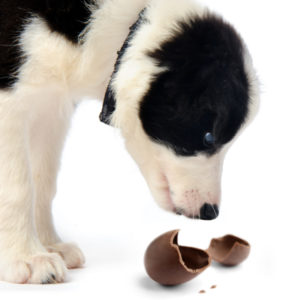
Dogs are known for eating things when they are not supposed to. This is especially true of puppies. Also, dogs have an excellent sense of smell, making it fairly easy to find any secret hiding spots for chocolate. This can be a dangerous combination when there is chocolate around the house or children with Easter eggs.
The foil that encloses the chocolate can also be potentially dangerous to animals as it can form a foreign body which may block the intestine and consequently require invasive surgery to remove.
Although dogs are most commonly affected, it is important to remember that cats and other species of animals can also be susceptible to the toxic effects of chocolate, as well.
What makes chocolate toxic?
Chocolate and cocoa are made from the fruit (beans) of the cacao tree.
The beans contain the compound Theobromine which is metabolised much more slowly in dogs and other animals than in humans. i.e. the half-life of theobromine in dogs is approximately 17.5 hours compared to 6-10 hours in humans. This inability for the body to clear the metabolites quickly results in chocolate toxicity.
Caffeine is a second toxic component of chocolate, although it is present in smaller concentrations. Both Theobromine and Caffeine are members of a drug class called Methylxanines.
It is important to note that Chocolate toxicity is not as much dependent on the amount of chocolate ingested, but more on the type of chocolate ingested. For example, white chocolate contains lower concentrations of methylxantines than cocoa beans or cooking chocolate which contain the highest.
| Chocolate type | Theobromine mg/100g | Caffeine mg/100g |
|---|---|---|
| White Chocolate | 0.9 | 3 |
| Milk Chocolate | 155-210 | 21 |
| Dark Chocolate | 490-850 | 80 |
| Cooking Chocolate | 1,400 | 125-170 |
Generally life threatening signs and seizures will be seen in animals that have consumed doses of 60 mg/kg. However the American Society for the Prevention of Cruelty to Animals and Poison Control Centre (ASPCA APCC) has reported doses as low as 20 mg/kg have caused clinical signs.
The Lethal Dose (LD) of both theobromine and caffeine is approximately 100-200 mg/kg.
Other factors which may influence whether a dose is toxic include the size of the animal (i.e. smaller animals are more prone to toxicity), individual sensitivity to chocolate, amount of gastric contents in the stomach at the time of ingestion.
Clinical Signs
Onset of clinical signs following ingestion of chocolate at a toxic dose is rapid. Due to the multiple effects theobromine and caffeine have on the body the following symptoms may be seen.
Initial symptoms include: hyperactivity, behaviour abnormalities and vomiting with possible diarrhoea.
Signs will progress rapidly to panting, cyanosis, increased heart rate, arrhythmias weakness/ataxia, diuresis resulting in increased urination, diarrhoea, severe hyperactivity, cardiac dysrhythmias (e.g. ventricular fibrillation) progressing to seizures then death.
Treatment
The key parameter which will affect the patient prognosis is the time between chocolate consumption to receiving treatment.
Initial treatment will usually involve inducing the dog to vomit. This is usually most successful if chocolate ingestion has occurred within 4 hours, however induction after 4 hours has also proven to be successful in some cases.
Lavage should be performed if emesis is contraindicated. Lavage must be performed with warm water to help soften the chocolate – cold water may decrease the amount of chocolate to be removed.
It is recommended to encourage the patient to empty the bladder regularly which helps prevent theobromine absorption through the bladder mucosa. This can be achieved by frequent walks or the placement of a urinary catheter. Fluid diuresis may also aid in excretion.
General supportive treatment: IV fluids, Muscle relaxants or barbiturate anaesthetics to control seizures and treatment of arrhythmias.
Avoid corticosteroids and erythromycin: they interfere with the excretion of methylxanthines.
For more information
Sudhakara Reddy, Bhavanam & LSS, Varaprasad & Sivajothi, Sirigireddy. (2013). Chocolate Poisoning In A Dog. International Journal of Veterinary Health Science & Research. 16-17. 10.19070/2332-2748-130004.
Article courtesy of Bayer Animal Health Australia
Posted on 17 March 2016
Last updated on 11 December 2019
Tagged with: chocolate toxicity



